For centuries, Calico Cats have enchanted cat enthusiasts worldwide. Their distinctive tri-colored coats make them instantly recognizable and endlessly fascinating. Sharing your life with a calico is a unique experience, and many who do become devoted admirers of these special felines.
If you’re captivated by calico cats and eager to learn more, you’ve landed in the perfect spot.
In this comprehensive guide, we will delve into the world of calico cats, exploring:
- The defining characteristics of a calico coat
- The diverse variations within the calico pattern
- The captivating origin of the name “calico”
- Clarifying whether “calico” denotes a breed
- Identifying breeds that can exhibit the calico pattern
- Distinguishing between calico and tortoiseshell cats, highlighting their similarities and differences
- Unraveling the fascinating genetics behind the calico coloration
- Understanding the rarity of male calico cats
- Guiding you on where to find and adopt your own calico cat or kitten
Prepare to embark on a journey to become a true calico connoisseur!
Ready to immerse yourself in the captivating world of calico cats? Let’s begin!
Decoding the Calico Coat Pattern
What exactly defines a calico cat’s coat pattern? The hallmark of a calico is the presence of three colors in their fur, with white being an essential component. The classic calico showcases a striking combination of white, black, and orange/red.
Given their signature three-color coat, calico cats are also aptly referred to as tri-color cats.
 A classic calico cat with distinct patches of black, orange, and white, sitting regally on a purple couch under bright studio lighting.
A classic calico cat with distinct patches of black, orange, and white, sitting regally on a purple couch under bright studio lighting.
The black element in a calico’s coat can present itself in various shades and patterns, including:
- Gray tabby: A swirling or striped pattern in gray tones, adding depth to the black patches.
- Blue (slate gray): Also known as diluted black, this offers a softer, muted gray hue, lending a gentle touch to the calico palette.
Similarly, the red element offers a spectrum of variations:
- Red tabby: Stripes or swirls in vibrant red, bringing warmth and energy to the coat.
- Cream tabby: A softer, paler version of red tabby, offering a delicate contrast.
- Cream: Also known as diluted red, this is a gentle, ivory-like shade, creating a subtle and elegant calico appearance.
A particularly charming variation is the dilute calico, characterized by a coat of white, blue, and cream. We’ll explore dilute calicos in greater detail shortly, along with the fascinating interplay of the tabby pattern within the calico mix.
Calico vs. Tortoiseshell: Untangling the Tri-Color Mystery
The defining characteristic of a calico cat is its tri-colored coat featuring a predominantly white base adorned with distinct, large patches of two other colors. The greater the expanse of white, the more pronounced and separate the color patches appear.
Conversely, as the white area diminishes, the red and black hues begin to intermingle more closely. The patches become smaller, leading to a more blended appearance.
In some cats, the white vanishes entirely, resulting in a tightly interwoven tapestry of red and black – the captivating tortoiseshell pattern.
Essentially, tortoiseshell cats, affectionately known as “torties,” are calicos that lack white in their coats. This close relationship is why they are often grouped together as tri-color cats, even though tortoiseshell coats technically display only black and orange (or their dilute variations).
 A tortoiseshell cat with a rich mix of black and orange fur, showcasing the characteristic mottled pattern with no white.
A tortoiseshell cat with a rich mix of black and orange fur, showcasing the characteristic mottled pattern with no white.
The Tabby Intrigue: Weaving Stripes into the Calico Tapestry
You may have heard the saying, “all cats are tabbies at heart.” Indeed, the tabby pattern is believed to be the original coat pattern of domestic cats, a legacy we still see in wild felines today.
Think of tigers with their bold stripes, leopards with their striking spots, and even lions, which are actually agouti tabbies. The tabby pattern serves as masterful camouflage, helping these feline predators blend seamlessly into the shadows as they stalk their prey.
Over millennia of domestication, genetic mutations have introduced new cat colors and patterns that can mask the underlying tabby. Yet, every so often, the tabby markings subtly re-emerge.
White is the only color that truly obliterates the tabby pattern, leaving no visible trace. Black is also quite effective at concealing tabby markings, although in certain lighting, a faint underlying tabby pattern may still be discernible. Red, however, is a different story – it almost invariably reveals the tabby pattern with remarkable clarity.
And where do calicos fit into this tabby tale?
Since red is a fundamental color in the calico palette, tabby markings are frequently visible within a calico’s coat, particularly in the red areas. Look closely at the red patches, especially on the forehead, and you might spot the iconic tabby “M” marking.
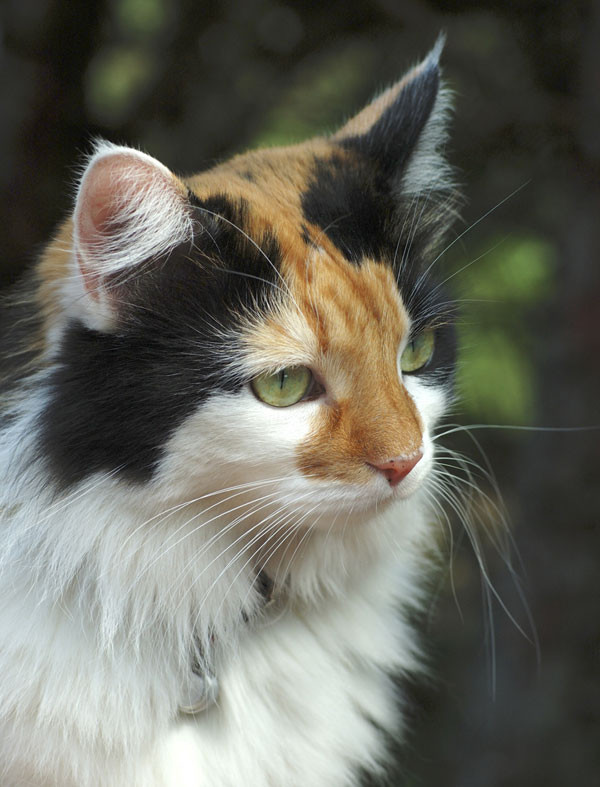 A calico cat displaying a distinct tabby 'M' marking on its forehead within the orange patch of fur.
A calico cat displaying a distinct tabby 'M' marking on its forehead within the orange patch of fur.
Some calicos embrace the tabby pattern even more fully. Their coats may feature pure white alongside gray tabby instead of solid black, and, of course, red tabby in the orange areas, creating a harmonious blend of patterns and colors.
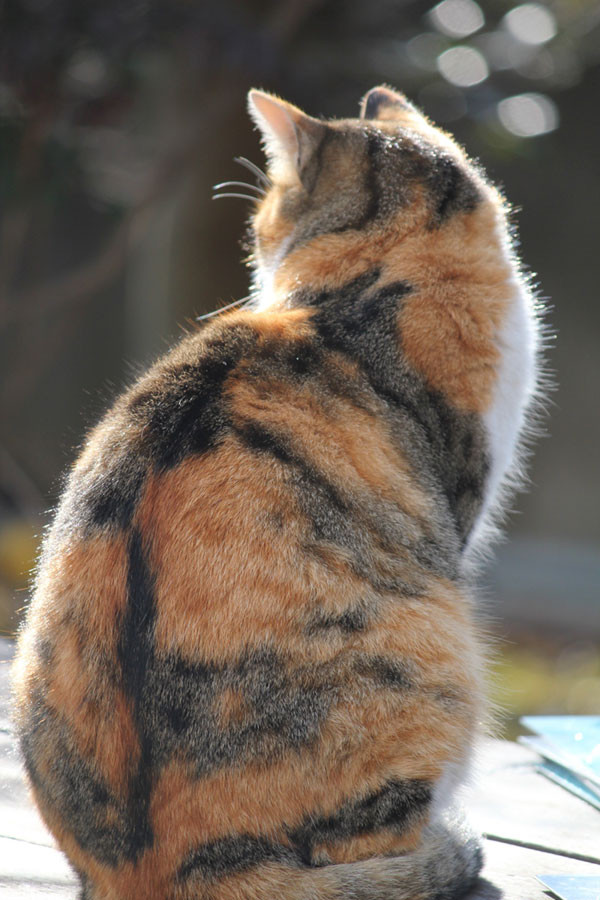 A calico cat showcasing prominent tabby markings within both the gray and orange patches of its tri-colored coat.
A calico cat showcasing prominent tabby markings within both the gray and orange patches of its tri-colored coat.
Unraveling the Etymology: The Meaning Behind “Calico”
The name “calico” boasts a rich and fascinating history. Linguists trace the word’s origins back to the mid-16th century, derived from “Calicut,” the name of a bustling seaport in India. Calicut was renowned for producing a unique fabric, also called calico, which was traded globally.
This distinctive Calicut fabric was primarily white, but adorned with vibrant, colorful patterns featuring patches of orange-red and black. The fabric was sometimes referred to as “Kalko,” a variation of “Calicut.” Over time, any pattern combining white with other color patches became known as “calico.”
Initially, “calico” was used to describe horses with this speckled coloration. Historical records indicate that the term began to be applied to cats around the 1880s, solidifying the link between the fabric pattern and the feline coat.
So, yes, our beloved calico cats are indeed named after a patterned fabric, a testament to the visual resemblance between the textile and their striking coats!
Calico: A Color, Not a Breed
It’s crucial to understand that “calico” refers to a coat coloration, not a specific breed of cat. You won’t find a “Calico breed” in the feline world.
The calico coloring can appear in a multitude of cat breeds, encompassing both long-haired and short-haired varieties, and even in some other animal species.
Which Breeds Can Sport the Calico Pattern?
A common question among cat enthusiasts is, “Which cat breeds are calicos?” While there’s no breed where calico is the sole allowed pattern, many popular breeds can exhibit the calico coloration as one of their accepted patterns. These include:
- Persian
- Maine Coon
- American Shorthair
- Exotic Shorthair
- Manx
- Oriental
- Siberian
- Scottish Fold
- Sphynx
Interestingly, while colorpoint breeds cannot technically be calico, some allow for a “parti-color” pattern in their points. This means that these cats possess the same underlying genetic makeup as calicos, and importantly, they will also be female. We’ll delve deeper into the captivating genetics of calicos and the reason for their predominantly female nature shortly. For now, consider that a colorpoint Ragdoll, for instance, can be classified as having “tortie” points, essentially mirroring the calico pattern in a colorpoint cat!
Conversely, certain cat breeds genetically cannot exhibit the calico coat pattern. Breeds like Bengals, Abyssinians, and Bombay cats have coat patterns that inherently preclude the possibility of calico patches or even tortie elements.
The Genetic Enigma of Calico Cats
Calico cats are overwhelmingly female – though the rare male calico does exist. Why this striking sex bias? The answer lies in their fascinating genetic makeup.
Genetics 101: Sex Chromosomes and Color
In most mammals, sex is determined by a pair of sex chromosomes, which come in two variations:
- X and Y
- X and X
An XY chromosome combination results in a male, while XX chromosomes designate a female.
During reproduction, each parent contributes one chromosome from their pair. The female can only pass on an X chromosome. The male, however, can pass on either an X or a Y chromosome.
If the male contributes an X chromosome, the offspring inherits two X chromosomes (XX) – resulting in a female. If the male contributes a Y chromosome, the offspring receives an X (from the mother) and a Y (from the father), creating an XY combination – a male.
The Calico Connection: Chromosomes and Coloration
Chromosomes house the genes that dictate an organism’s traits. In cats, the X chromosome is the key player in coat color, capable of carrying the gene for black coloration or the gene for orange coloration. Crucially, it can only carry one of these color genes, not both.
Male cats, possessing only one X chromosome (XY), can therefore inherit either the black gene or the orange gene, but not both simultaneously. This explains why male cats can be black or orange, but typically not both.
Female cats, with their two X chromosomes (XX), have the genetic potential to inherit one X chromosome carrying the orange gene and another X chromosome carrying the black gene. The combination of black and orange genes, expressed in the coat, is what creates the calico pattern!
This genetic mechanism is the primary reason why calico cats (and tortoiseshell cats) are almost exclusively female. Any cat displaying a combination of black and red, or their dilute versions like blue and cream, is, by genetic definition, almost certainly female.
We will explore the intriguing phenomenon of male calico cats shortly. But first, let’s understand how the white color element enters the calico equation.
X-Inactivation: The Art of Patchwork Color
The distinctive patched coat pattern of calico cats is a result of a fascinating process called X-inactivation, which occurs during embryonic development (when a tiny kitten is just beginning to form).
During X-inactivation, in each cell of the developing embryo, one of the two X chromosomes is randomly inactivated. In cells destined to become fur, this means that either the X chromosome carrying the black gene or the X chromosome carrying the orange gene is randomly activated.
Once a color gene is activated in a cell, all the hair follicles originating from that cell will inherit that specific coloration. This random activation across different cells leads to the characteristic patchwork of black and orange.
Interestingly, some cells in the developing embryo may not have either the black or orange genes activated. These areas, devoid of either color gene expression, develop into the white patches that are essential to the calico coat pattern.
Practical Implications: Sexing Kittens and More
This unique genetic inheritance pattern provides a valuable practical tool: a calico or tortoiseshell coat pattern strongly indicates that a cat is female. This can be particularly helpful when trying to determine the sex of kittens.
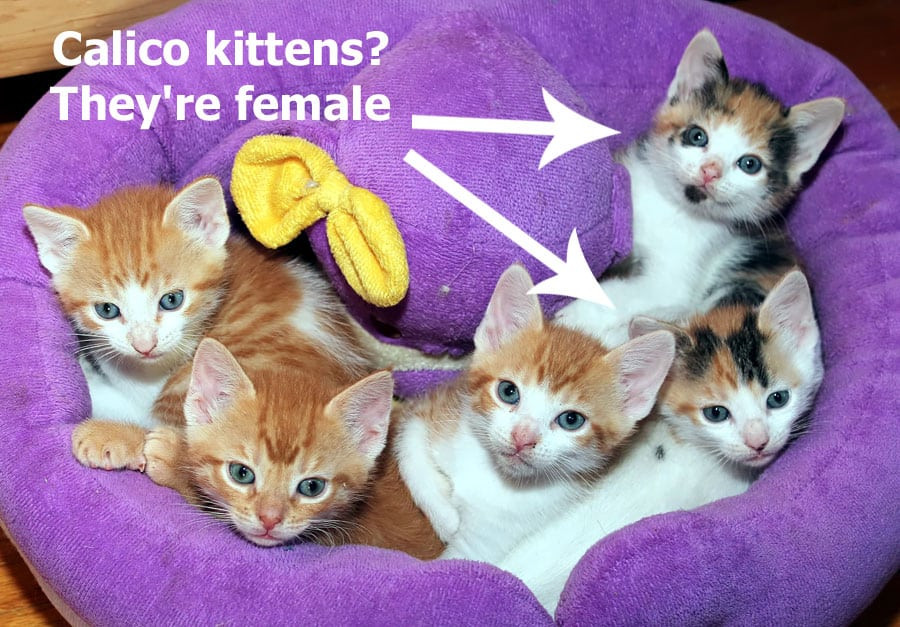 A visual guide on how to sex kittens, specifically highlighting that calico kittens are almost always female.
A visual guide on how to sex kittens, specifically highlighting that calico kittens are almost always female.
Animal rescuers can also quickly assess the sex of a feral cat from a distance if she exhibits a calico coat.
And, of course, you can impress your friends with your feline knowledge by confidently declaring a cat’s female sex simply by observing its calico coat!
Calico vs. Tortoiseshell: A Closer Look at the Differences
We touched on tortoiseshell cats earlier, but now, armed with an understanding of calico genetics, let’s revisit the nuances between these two tri-color patterns.
Calico cats are characterized by distinct, well-defined patches of solid colors, including white. The presence of white is a key differentiator. Calicos are often called tricolor cats due to their prominent orange, black, and white coloration. Remember, a significant amount of white in the coat is necessary for a cat to be classified as calico, along with substantial splashes of black and orange.
Tortoiseshell cats, in contrast, exhibit a predominantly red/orange and black pattern (or their dilute variations) that is interwoven and blended. These cats tend to have a darker overall appearance due to the black and brown hues. Their patterns can range from mottled and speckled designs to larger areas of solid color, but typically with highly integrated color breaks.
 A classic tortoiseshell cat with a rich, interwoven pattern of orange and black, exemplifying the characteristic tortie look.
A classic tortoiseshell cat with a rich, interwoven pattern of orange and black, exemplifying the characteristic tortie look.
A dilute tortie showcases a bluish-gray overall appearance interspersed with cream specks, a softer, muted version of the classic tortoiseshell.
The distinction between calico and tortoiseshell isn’t always absolute, and there can be cats that fall somewhere in between. However, a simple rule of thumb is: the presence of white generally signifies a calico. No white at all? You’re likely looking at a tortie.
Dilute Calico: Softening the Calico Palette
Now that we’ve explored the genetic underpinnings of coat color, let’s briefly examine dilute calicos.
The black and red colors in cats have “dilute” versions, created by a separate gene that reduces pigment concentration in the hair, resulting in a softer, muted shade of the original color.
Solid blue cats are, in fact, the dilute version of black cats. Cream tabbies are the dilute counterpart to red tabbies.
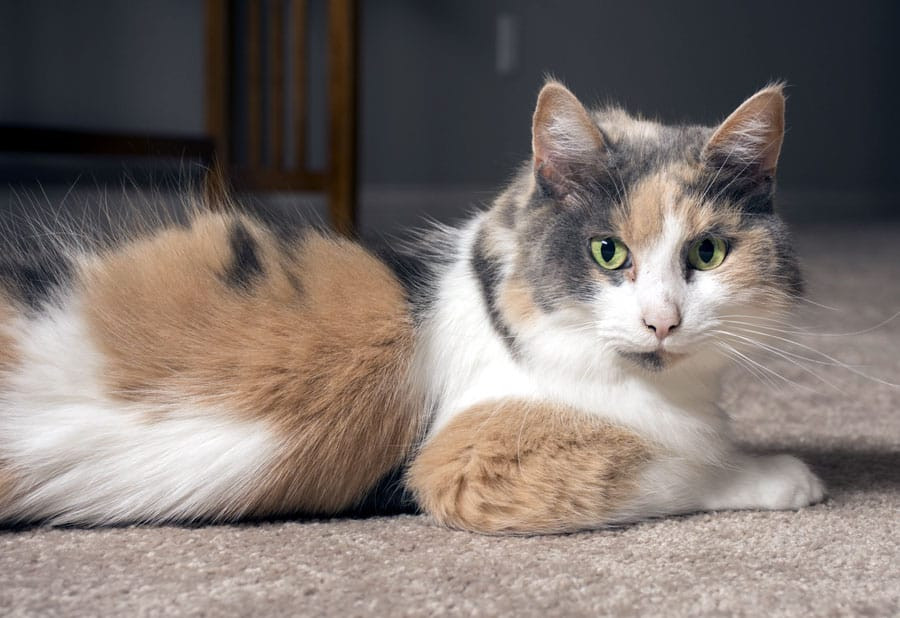 A dilute calico cat showcasing a gentle mix of white, blue-gray, and cream patches, creating a pastel-like appearance.
A dilute calico cat showcasing a gentle mix of white, blue-gray, and cream patches, creating a pastel-like appearance.
Combine black and red, and you get a calico or tortie. Combine their dilute counterparts, blue and cream, and you get a dilute calico or dilute tortie. Dilute calicos feature white, blue, and cream patches, while dilute torties display a blended mix of blue and cream, without white.
 A dilute tortie cat with a blended coat of blue-gray and cream, exhibiting the characteristic tortie pattern in softer hues.
A dilute tortie cat with a blended coat of blue-gray and cream, exhibiting the characteristic tortie pattern in softer hues.
Male Calico Cats: The Exceptionally Rare Gentlemen
Yes, male calico cats do exist, but they are exceptionally rare.
Recall that males typically have XY chromosomes, while females have XX. Calico cats require two X chromosomes to carry both the black and orange color genes. So, how can a male cat inherit both color genes and display a calico pattern?
The answer lies in a chromosomal abnormality. Rare male calico cats possess an unusual XXY chromosome combination, instead of the typical XY. The Y chromosome triggers the development of male characteristics, while the presence of two X chromosomes allows for the expression of both black and orange color genes, resulting in the calico pattern.
Due to their rarity, male calico cats are often highly sought after and can command a premium price. The exact cost of a male calico is difficult to pinpoint, as rarity often drives up perceived value, and price depends on finding a willing buyer.
However, it’s important to note that this XXY chromosomal makeup is indeed an abnormality. Beyond the unique calico coat, male calicos are unfortunately prone to various health issues and are almost always infertile.
Calico Cat Personality: Beyond the Coat Colors
Determining personality traits objectively in scientific studies is challenging, which is why definitive answers about calico-specific personalities remain elusive. No one can definitively say if calico cats possess unique personality traits solely due to their coat color.
However, anecdotal evidence and folklore abound! Many calico cat owners believe their tri-colored companions do exhibit distinct characteristics. Traditionally, calico cats (and tortoiseshell cats) are often described as possessing sassy and fiercely independent personalities. Yet, they are also known for being deeply loyal and affectionate towards their chosen humans.
Other attributes commonly associated with calico and tortoiseshell cats include:
- Strong-willed
- Possessive
- Feisty
- Very vocal
- Temperamental
- “Cattitude” (that quintessential cat-like attitude)
- A higher prevalence of quirks and idiosyncrasies
Ultimately, it’s crucial to remember that personality is individual, and each cat, regardless of coat color, will have its own unique temperament. Personalities vary widely, and generalizations should be taken with a grain of salt.
Many members of TheCatSite community who own calico cats report having mellow, loving kitties. Our collective experience suggests that calicos and torties are not inherently more “difficult” than cats of other coat colors.
Calico Cat Health: Are There Specific Concerns?
Generally, calico cats do not have unique health problems directly linked to their coat coloration.
Certain breeds, however, are predisposed to specific health issues due to limited genetic diversity within the breed. Calico cats belonging to these breeds might be at risk for breed-typical health problems, but these are breed-related, not calico-related.
A domestic shorthair or longhair calico cat, meaning a mixed-breed calico, is typically a healthy and happy cat with no particular health predispositions.
The exception, as mentioned earlier, is male calico cats. Their rare XXY genetic makeup makes them susceptible to a range of health problems.
Regardless of coat color or sex (except for the XXY males), providing your calico cat with proper care, nutrition, and veterinary attention will ensure a long and healthy life.
Finding Your Calico Companion: Adoption and Beyond
If you’re emotionally and financially ready to welcome a cat into your life, should you consider a calico cat?
Absolutely! If the captivating calico coat pattern resonates with you, that’s reason enough. Our site survey indicates that many people have a preference for particular cat coat colors, and calico is undoubtedly a popular choice.
If you’re set on owning a cat and drawn to the calico pattern, you’re in luck! Countless calico cats are waiting for loving homes in shelters and rescues near you.
Reach out to your local animal shelters and rescue organizations to inquire about available calico cats. Sadly, many wonderful cats and kittens end up in shelters through no fault of their own, often due to circumstances like divorce, allergies, or changes in living situations.
Should you adopt a calico kitten or an adult cat? Both options have their pros and cons. We encourage you to read our article “A Kitten Or An Older Cat – Which Should You Adopt?” to help you make an informed decision.
If you desire a calico-patterned cat within a specific breed, you’ll need to connect with reputable breeders specializing in those breeds. Since calico is a color pattern, it can occur in any of the breeds we listed earlier. Prices for purebred cats vary significantly, and pedigree cats, calico or otherwise, will typically come with a higher price tag. Before choosing a breeder, we recommend reading our guide “How To Choose A Cat Breeder”.
Are You Now a Calico Cat Expert?
How well-versed are you in the world of calico cats? Having journeyed through this guide, we hope you’ve gained a deeper appreciation for these tri-colored marvels. Don’t forget to share your thoughts and questions in the comments below!
Final Words:
Is there a special calico cat enriching your life? We’d love to hear about her (or him, however rare!) in the comments, and feel free to share a picture too!
A considerable amount of effort went into crafting this comprehensive guide. If you found it informative and enjoyable, please help us spread the word by sharing it on Facebook or Pinterest!
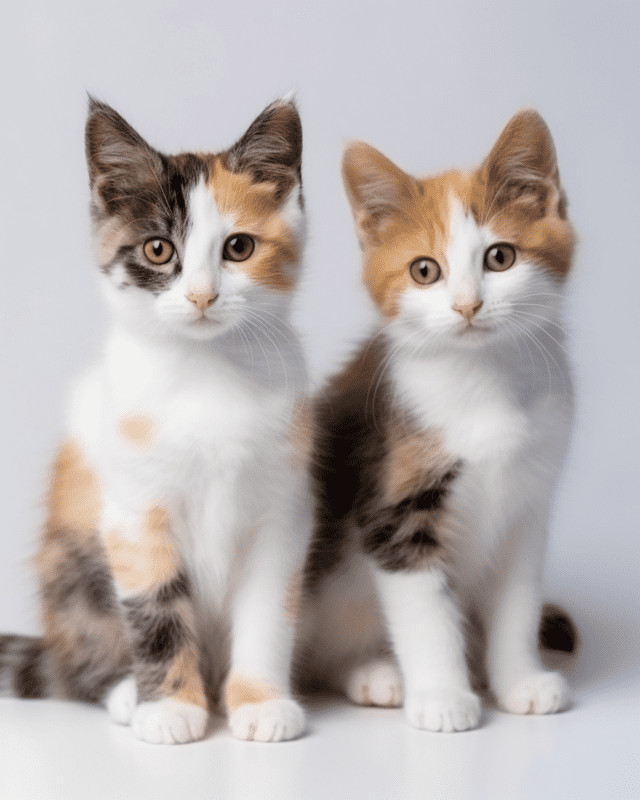 Two adorable calico kittens nestled together against a white home background, bathed in soft, high-key lighting.
Two adorable calico kittens nestled together against a white home background, bathed in soft, high-key lighting.
Note: We may receive commissions for purchases made through links on this page.
